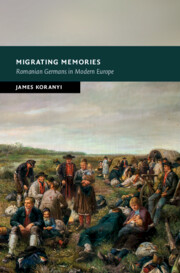Book contents
- Migrating Memories
- New Studies In European History
- Migrating Memories
- Copyright page
- Dedication
- Contents
- Figures
- Acknowledgements
- Note on the Text
- Introduction Stories, Identities, Memories
- Chapter 1 Making Romanian Germans
- Chapter 2 Transnational Germans
- Chapter 3 Fascist Divisions in the Romanian German Past
- Chapter 4 The Iron Memory Curtain: Romanian Germans and Communism
- Chapter 5 European Bridge-Builders: Romanian Germans after 1989
- Epilogue The Perpetual Exodus
- Bibliography
- Index
Chapter 1 - Making Romanian Germans
Published online by Cambridge University Press: 09 December 2021
- Migrating Memories
- New Studies In European History
- Migrating Memories
- Copyright page
- Dedication
- Contents
- Figures
- Acknowledgements
- Note on the Text
- Introduction Stories, Identities, Memories
- Chapter 1 Making Romanian Germans
- Chapter 2 Transnational Germans
- Chapter 3 Fascist Divisions in the Romanian German Past
- Chapter 4 The Iron Memory Curtain: Romanian Germans and Communism
- Chapter 5 European Bridge-Builders: Romanian Germans after 1989
- Epilogue The Perpetual Exodus
- Bibliography
- Index
Summary
Who are these Romanian Germans? This chapter maps out the materials from which Romanian Germans constructed their identity from the late nineteenth century into the interwar period. It starts with an overview of the history of Germans in the region before engaging in detail with three key identity myths that emerged from and around that history. The final section embeds those identity narratives in a transnational web of reception and affirmation spanning interwar Europe. In making sense of their experiences in the twentieth century, this chapter argues, Germans in Romania used long-standing narratives that had been important to the two communities of Saxons and Swabians, picking and choosing older ‘foundation myths’ from these groups according to the needs of the circumstances in which they found themselves. These myths were highly malleable and usable by a variety of actors in the community, not just elites. Romanian Germans thus returned to three key themes time and again: Saxon privilege and superiority, a sense of being under siege, and the Swabian path of ordeal.
Keywords
- Type
- Chapter
- Information
- Migrating MemoriesRomanian Germans in Modern Europe, pp. 22 - 62Publisher: Cambridge University PressPrint publication year: 2021

